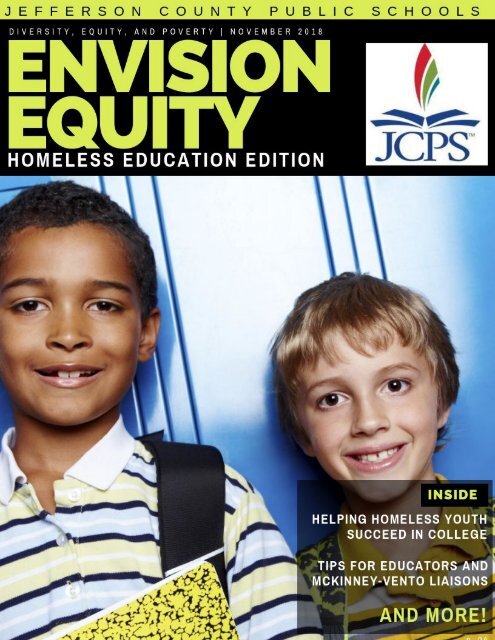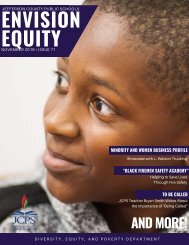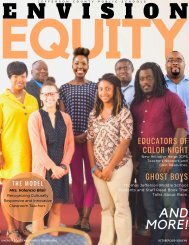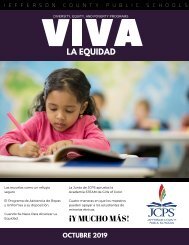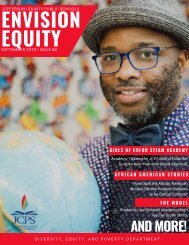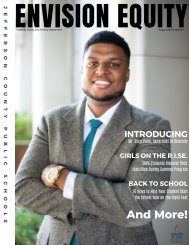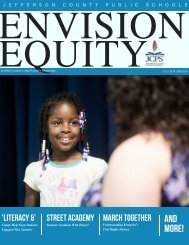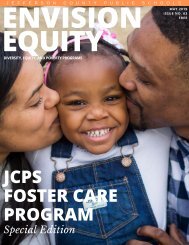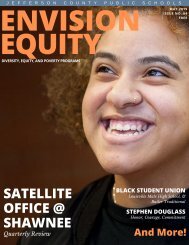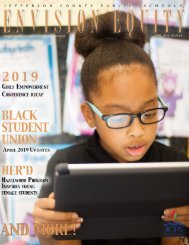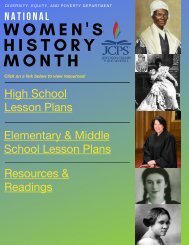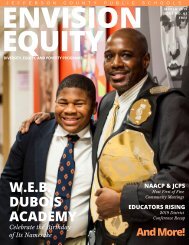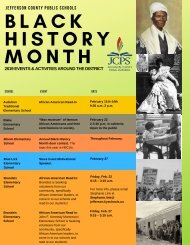2018 Homeless Edition
Create successful ePaper yourself
Turn your PDF publications into a flip-book with our unique Google optimized e-Paper software.
1<br />
Photo, Getty Images
ENVISION EQUITY HOMELESS EDUCATION SPECIAL EDITION<br />
Helping <strong>Homeless</strong> Youth<br />
Succeed in College<br />
By Giselle Danger-Mercaderes<br />
Postsecondary education is becoming increasingly vital for gaining employment that pays<br />
enough to afford housing. Postsecondary education is an important determinant in<br />
breaking the cycle of homelessness and improving overall well-being of youth<br />
experiencing homelessness.<br />
The Every Student Succeeds Act of 2015 (ESSA) supports the transition to postsecondary<br />
education for homeless students. Under the Act, local educational agency (LEA) homeless<br />
liaisons are required to ensure that unaccompanied homeless youth are informed of their status<br />
as independent students for college financial aid and obtain assistance to receive verification for<br />
the FAFSA. Another important mandate is that State McKinney-Vento plans must describe how<br />
homeless youth will receive assistance from school counselors to improve their readiness for<br />
college.<br />
<strong>Homeless</strong> students often face difficult barriers to transition to college. Barriers can be<br />
particularly challenging for homeless you who have histories of trauma, mobility, and lack of<br />
natural family support. Teachers, counselors, McKinney-Vento liaisons, school homeless liaisons<br />
and service providers can play a key role in supporting the decision to go to college and assisting<br />
youth in the transition.<br />
2
WHEN THERE IS NO HOME:<br />
SUPPORTING UNSHELTERED<br />
FAMILIES AND YOUTH<br />
By Julie McCullough<br />
With contributions from Erin Klein and Tonia Nolden<br />
It’s Friday, October afternoon in Jefferson<br />
County. The temperatures during the day is a<br />
comfortable 65. Families and children are on<br />
their way home from work and school. Most<br />
of them are thinking about the fun Fall<br />
activities they will experience this weekend.<br />
A few are consumed with entirely different<br />
thoughts. They are picking up their kids<br />
from school, riding the TARC, standing<br />
outside a shelter, or sitting in their car filled<br />
with the overwhelming stress and fear of<br />
homelessness. Their thoughts are flowing<br />
one after another: Where will we sleep<br />
tonight, I don’t even have enough gas to get<br />
to the shelter, the Coalition bed line said<br />
there is a wait list, the shelter is full, there are<br />
no resources, I can’t afford a TARC ticket,<br />
it’s getting late, it’s getting colder, Where<br />
will I go…<br />
Every afternoon students in JCPS leave<br />
school to these questions. Weekends are likely the worst time for these students as they are not even<br />
sure if they will have a safe place to return to until Monday morning when school starts again.<br />
This year the Office of Student Equity and Community Engagement has encountered significantly<br />
more unsheltered families than in years past. Last year on average about one family a month was<br />
identified as living in a car, in a foreclosed property, on the streets, etc. Most of these families were<br />
able to obtain shelter quickly, sometimes within 24 hours. This year our office is often tracking at<br />
least one to two families a week that are currently living in this situation or recently identified as<br />
unsheltered.<br />
3
Unfortunately, the shelters are full, and have been full since this summer. Right now, it is truly a<br />
challenge to find shelter and housing for families experiencing homelessness in Louisville. So<br />
how do we support our most vulnerable families and youth? We interviewed staff from<br />
Louisville Coalition for The <strong>Homeless</strong> to provide some insight into the problem set and answers<br />
to this question.<br />
Coalition for the <strong>Homeless</strong> has a multitude of supports and programs that are set out to prevent<br />
homelessness or support persons experiencing homelessness. Their prevention and diversion<br />
program specifically, will work to prevent families and individuals from becoming unsheltered.<br />
They have advocates that will work with community resources, mediate with family members,<br />
work with landlords, reach out to our schools and district, etc. They also have a housing<br />
Navigator that will assist families with locating affordable housing. The prevention and<br />
diversion program will<br />
also conduct<br />
assessments and verify<br />
homelessness. They<br />
will then use those<br />
assessments to<br />
determine programs<br />
best suited for the<br />
family or individual<br />
and connect them to a<br />
multitude of resources<br />
throughout the city.<br />
Coalition for the<br />
<strong>Homeless</strong> is also the<br />
single point of entry<br />
for all shelter spaces in<br />
the city. They manage<br />
the family wait list for shelters. As such they have an existing relationship with the shelters so<br />
that when a space does become available they are the first to know and have the opportunity to<br />
make referrals.<br />
One of the most important things for school and district staff to understand when explaining the<br />
shelter system to a family is that Coalition for the <strong>Homeless</strong> is the Single Point of Entry for all<br />
shelter space in the city. There is an existing wait list that is prioritized not by when you call, but<br />
by a needs assessment. Every family is different, and every situation is different. A multitude of<br />
factors will determine the families’ priority for shelter. Furthermore, the Coalition for the<br />
<strong>Homeless</strong> will scrub the list on a regular basis. Therefore, it is important for families to call on a<br />
regular basis. Our office recommends families call every two days or every time their shelter/<br />
housing situation changes. Since Coalition for the <strong>Homeless</strong> also has prevention programs<br />
families should also call when they first believe they may experience housing instability, such as<br />
receipt of an eviction notice.<br />
4
For schools in contact with unsheltered families, it is important to be sensitive, but also set<br />
realistic expectations with parents about the situation. As it stands there is currently an eviction<br />
crisis and lack of affordable housing in the metro area. Therefore, families currently in shelters,<br />
even those that already have housing vouchers, are struggling to obtain the housing needed to<br />
move out of the shelter.<br />
This has contributed to a<br />
lack of turnover, and<br />
families that have<br />
recently lost housing are<br />
now waiting on the<br />
limited shelter spaces<br />
that exists. Ultimately,<br />
even unsheltered<br />
families may wait a<br />
number of weeks before<br />
obtaining shelter. Some<br />
may meet criteria that<br />
help them obtain shelter<br />
a little quicker, but it still<br />
may be several days or<br />
more. It is important to<br />
inform families that<br />
obtaining immediate<br />
shelter may not be<br />
possible on a given day.<br />
Staff at the Office of Student Equity & Community Engagement know firsthand this is a hard<br />
conversation to have. To make the conversation easier we recommend a few things. First, listen.<br />
Families experiencing homelessness are exposed to an incredible amount of stress and trauma.<br />
This may be expressed in any number of ways to include: a quiet resolute demeanor, crying,<br />
yelling, etc. One of the best things we can do to support a family when they are explaining their<br />
situation is to just listen. When a family senses that we are listening, they are more likely to open<br />
up and share not only their full situation, but details that may be helpful in seeking resources for<br />
their support. Even when we cannot solve the problem in that moment, the family at least has the<br />
opportunity to express their feelings This lets them know you care. The next aspect of the<br />
conversation may be to address any concerns or fears that the family has about confidentiality or<br />
reporting. One of the biggest fears families may have is that they will be reported to Child<br />
Protective Services if they do not have a home, running water, heat, etc. <strong>Homeless</strong>ness in and of<br />
itself is not a reportable offense. It is critical that we let our families know this and help them feel<br />
comfortable sharing their story, so they can obtain needed resources. Finally, do not make any<br />
5
false promises. Be supportive, but do not set expectations. We build trust by being honest, and<br />
following through with what we can do.<br />
Staff from the Coalition for the homeless prevention and diversion team had several other<br />
recommendations that may be helpful for our families. As stated previously, the first<br />
recommendation is always for the family to call the Coalition for the <strong>Homeless</strong> and get support as<br />
early as possible to try and prevent the family from becoming unsheltered. Once a family reaches<br />
out to the Coalition it is important to maintain regular contact with this office. They should also<br />
update critical information such as their living situation which may change the priority for shelter,<br />
and their phone number which will impact the ability for the<br />
Coalition to reach a family when shelter space becomes available.<br />
Next, we should ask the family or youth about family and friends if<br />
they have not mentioned this already. We can ask the family is there<br />
is anyone they know that would allow them to stay with them for a<br />
little while to provide a reprieve. The family can try to reach out and<br />
explain the situation. Even family members that have not had<br />
contact in a while may be willing to help once they hear the situation.<br />
Another preventive measure schools can take is to build relationships<br />
with local resources. Having an existing relationship with nearby<br />
resources will make it easier to reach out when a family is in crisis<br />
with nowhere to go.<br />
Student Equity and Community Engagement will also work with schools to try and maintain<br />
contact with any unsheltered families. When the temperatures are extreme we should remind them<br />
that specific shelters (Salvation Army, Wayside, and St. Vincent DePaul (Men)) will take in any<br />
unsheltered adults and families during white flag conditions. In addition, youth under 18 are<br />
always welcome at Safe Place. Unfortunately, there are unsheltered families and youth in<br />
Louisville. When we are aware that the temperatures have met white flag criteria we should reach<br />
out to our families in this situation and make sure they are aware they can go to the shelter. We are<br />
always honest with our families and explain that the shelter might not be comfortable. If there is no<br />
family space, the family may end up sleeping on mats on the floor. While it is not comfortable, it<br />
is a reprieve from the heat or the cold with showers and warm food. This contact with a shelter<br />
may also benefit the family in the sense that it will lend evidence to the family’s situation which<br />
may ultimately increase the family’s priority level for shelter or housing. <br />
Finally, if there are no other options we recommend families go to Wayside shelter and request<br />
support. The family can always receive a meal and often take showers at this location. The<br />
Student Equity & Community engagement Office will provide TARC tickets for unsheltered<br />
families to get to a shelter for safety. If a family is living in a vehicle we may also calculate the<br />
distance from the school to the shelter to get the family back and forth to the school while the<br />
family is working to gain stable shelter.<br />
One of the biggest things schools and district staff can do is provide our families with helpful<br />
resources. Many of our families can “fill the gap.” The gap means the time that a parent may have<br />
6
while the child is in school. For some of our parents this time is filled with work. Others may<br />
use this time to seek out resources that may be helpful for their family. Resources specifically<br />
mentioned by Coalition staff include Jewish Family & Career Services (2821 Klempner Way,<br />
40205), The Nia Center (2900 W. Broadway, 40211), Community Ministries (http://<br />
www.louisvilleministries.org/) , Uniting Partners for Women and Children (day shelter for<br />
women and children, https://www.uplouisville.org/), Jump Start Kentucky (for youth 18-24,<br />
contact nthornton@trueuplouisville.com) TAYLRD (Youth 18-24, drop in center, http://<br />
www.taylrd.org/louisville_dropin_center.php) , Family Scholar House, and Project Keep Safe<br />
(Home of the Innocents program designed to provide care to children while parents receive<br />
treatment for health issues, substance abuse, etc). Additional resources our office refers<br />
families to are Neighborhood Place, Louisville Urban League, and the Housing Navigator<br />
(Alayna Winburn) at Coalition for the <strong>Homeless</strong>. Numerous other resources in Louisville can<br />
be found by category on a web application called LouieConnect (http://<br />
www.in4mingdesign.com/).<br />
Families can also be supported through both small and large efforts. Some of the little things<br />
many schools are already doing through there the Family Resource and Youth Service Centers<br />
include: keeping a bank of resources on hand (flyers, pamphlets, etc.) maintaining food,<br />
hygiene items, and uniforms on hand, providing Blessings in a Backpack, washing clothing<br />
items for students, and allowing students to take showers or wash up at the school before<br />
classes began. Schools could potentially even allow students to wash clothes after school hours<br />
based on school policy and if the school has a washer/dryer. Some of the larger supports<br />
Coalition recommended is holding a school resources fair; possibly at an activity parents will<br />
already be present for, such as parent teacher conferences. Schools could also create<br />
partnerships so that students can be served through shared resources. Another huge way,<br />
anyone in the city can help a family is by participating in the cities Host Home program. This is<br />
a pilot project in which volunteer families provide temporary housing for young adults from<br />
age 18-24. Those interested can find more information through the link provided here: http://<br />
louhomeless.org/host-homes/.<br />
One of the largest contributing factors to homelessness today is lack of affordable housing.<br />
Unfortunately, this is not an issue that can be addressed overnight. However, all of us can work<br />
to show compassion and support for our families experiencing homelessness. While we cannot<br />
always house or shelter a family overnight, we can work to provide them with the resources<br />
and tools needed to meet their most basic needs and obtain shelter as quickly as possible. We<br />
ask that our schools and community work to support our families, and maybe someday every<br />
child will go home on a Fall Friday excited for weekend activities.<br />
7
ENVISION EQUITY HOMELESS EDUCATION SPECIAL EDITION<br />
Tips for Educators<br />
and McKinney-Vento<br />
Liaisons:<br />
1. Support the homeless identification and<br />
make sure eligible students are connected<br />
with the Student Equity and Community<br />
Engagement Department.<br />
2. Reach out to McKinney-Vento eligible<br />
students as early as freshman year to<br />
schedule meetings to discuss postsecondary<br />
options (e.g. four-year institutions,<br />
community colleges, technical colleges,<br />
etc.). Continue meeting with these students<br />
throughout the year to answer questions,<br />
serve as a resource, and remind them of<br />
deadlines. Create a checklist to review each<br />
time you meet to keep them on track. 3. If<br />
students are interested in postsecondary<br />
education, make sure they take the ACT/<br />
SAT exams. Most low-income and<br />
homeless students will qualify for fee<br />
waivers (ACT & SAT). The Student<br />
Equity and Community Engagement can<br />
fund for ACT/SAT exams for homeless<br />
students when needed.<br />
4. Encourage all students to complete the<br />
FAFSA immediately. Even if students<br />
aren’t committed to postsecondary plans, it<br />
is important for them to fill out the FAFSA<br />
so they can receive financial aid if they do<br />
decide to attend higher education.<br />
5. There might be scholarship opportunities<br />
for students, including our Student Equity<br />
Conference and Scholarships.<br />
6. Host a college tour. A college tour is a<br />
great way to experience college life firsthand<br />
and imagine oneself there.<br />
7. Be aware of state laws that offer in-state<br />
tuition, tuition, and fee waivers like<br />
Florida, California, and Maryland.<br />
Tuition and/or Fee Waivers for youth<br />
experiencing homelessness<br />
California AB 801 (2016) (Ca.<br />
Educ. Code §76300)<br />
• <strong>Homeless</strong> students are exempt from<br />
paying community college student<br />
fees.<br />
Florida §1009.25 (1991)<br />
• A student who lacks a fixed, regular<br />
and adequate nighttime residence,<br />
or who lives in a shelter or a public<br />
or private place not ordinarily used<br />
as regular accommodation, is<br />
exempt from the payment of tuition<br />
8<br />
Continue on next page
ENVISION EQUITY HOMELESS EDUCATION SPECIAL EDITION<br />
and fees for a school district workforce education program, Florida College System<br />
institution, or state university.<br />
Maryland<br />
HB 482<br />
(2014) and<br />
HB 400<br />
(2016) (Ann.<br />
Code of Md.<br />
§15-106.1)<br />
unaccompanied homeless youth or foster care recipient is exempt from paying tuition<br />
at a public institution of higher education, if the youth is enrolled as a candidate for a<br />
vocational certification, associate’s degree or bachelor’s degree prior to turning 25<br />
years old and has applied for federal and state financial aid. Exemption lasts for five<br />
years or until the student receives a bachelor’s degree, whichever comes first.<br />
•An<br />
Washington SB 2674 (<strong>2018</strong>)<br />
• Through the Passport to Careers Program, unaccompanied homeless youth and foster<br />
youth receive a scholarship that assists with the cost of attending college (tuition, fees,<br />
books, housing, transportation, and some personal expenses). To meet eligibility<br />
requirements, students must be enrolled at least on a half-time basis with an institution<br />
of higher education or a registered apprenticeship or preapprenticeship in Washington<br />
state by age 21 and not pursue a degree in theology. An eligible student will receive<br />
the scholarship for a maximum of five years after the student first enrolls, or until the<br />
students turns 26 years old, whichever occurs first.<br />
9
ENVISION EQUITY HOMELESS EDUCATION SPECIAL EDITION<br />
A YEAR LATER AND LIFE IS<br />
NOT “ALL WELL” FOR MANY<br />
By Debra Albo-Steiger, District <strong>Homeless</strong> Liaison for the Miami-Dade County Public Schools. <br />
A<br />
ugust and September 2017 brought three powerful storms that affected three different regions<br />
of the United States. Hurricane Harvey made landfall on the Texas Gulf Coast on August 25,<br />
2017, Hurricane Irma made landfall in<br />
Florida on September 9, <strong>2018</strong>, and<br />
Hurricane Maria made landfall in Puerto<br />
Rico on September 20, 2017. Needless<br />
to say, these three storms affecting three<br />
areas in such short period of time<br />
impacted not only the lives of people<br />
and the infrastructure of the<br />
communities, but also the assistance<br />
needed for the victims of these storms.<br />
Immediately after Harvey, I reached out<br />
to the <strong>Homeless</strong> Liaison from Houston,<br />
who described the devastation and those<br />
she knew who lost everything from the storm. I offered whatever assistance that I could provide<br />
from Miami, not realizing that just a mere two weeks later, our community would also be hit by a<br />
storm. Overall, Miami-Dade County was “lucky” with Hurricane Irma, especially compared to<br />
neighboring Monroe County and the middle Florida Keys, which saw massive destruction. Our<br />
district missed seven days of schools and loss of power for one week on average, which was trivial<br />
compared to what we were seeing in Monroe County and Houston. When Hurricane Maria hit<br />
Puerto Rico less than two weeks later, no one could put into words the devastation we all saw on<br />
television and the stories we heard for months after as our community welcomed students from<br />
Puerto Rico into our schools.<br />
The trauma faced by the children, youth, and adults who experience hurricanes or any natural<br />
disaster can be felt for years. A year after these storms, we still see the hardship faced by so many<br />
with roofs that have not been repaired and homes that were not able to be saved. The support<br />
needed for our students who are in homeless situations, especially after facing such a crisis, can be<br />
10<br />
Continue on next page
overwhelming. As the <strong>Homeless</strong> Education Program, Project UP-START, we try to do our best to<br />
support our students<br />
without stable housing.<br />
During the 2017-<strong>2018</strong><br />
school year, the series<br />
of natural disasters that<br />
affected our country<br />
which destroyed the<br />
homes of youth and<br />
families due to<br />
hurricanes, floods, and<br />
fires was<br />
unprecedented. After<br />
Hurricane Irma<br />
disturbed the lives of so<br />
many in our own<br />
community, and then<br />
Hurricane Maria<br />
brought students and<br />
families from Puerto<br />
Rico and the U.S. Virgin Islands to Miami-Dade County, the importance of the McKinney-Vento<br />
sub-grant became evident more than ever. With the help of the McKinney-Vento sub-grant, we are<br />
able to serve our students who have been displaced from their homes by offering resources during<br />
a very vulnerable time in their lives. Losing a home is devastating both physically and<br />
emotionally, especially when so many families are separated during homelessness. Thankfully, our<br />
Project UP-START team through the McKinney Vento sub-grant ensures that our students are able<br />
to have the tools they need to succeed both inside and outside the classroom, even when they are<br />
without a place to call home.<br />
Our thoughts are with those affected by Hurricanes Michael and Florence, as well as the many<br />
other natural disasters that have impacted so many parts of the country. Please know that our<br />
community and so many others are available to assist in whatever way we can whenever you are<br />
ready for us. A year later and still in the process of rebuilding, we remember those who reached<br />
out to us after Hurricane Irma and are grateful to continue to help students in our community and<br />
other communities throughout the country experiencing homelessness due to natural disasters.<br />
11
ENVISION EQUITY HOMELESS EDUCATION SPECIAL EDITION<br />
DISASTER<br />
RESPONSE TOOL<br />
By Milenia Hernandez<br />
In Jefferson County Public School each school has a McKinney-Vento liaison that can support and connect with families<br />
with needed services. This will allow us to respond to hurricanes and other natural disasters effectively.<br />
School districts that have been impacted heavily by disasters agree that the McKinney-Vento Act was the cornerstone of their<br />
response. The following basic checklist can guide the immediate responses to support displaced students.<br />
Checklist<br />
1. It is crucial to identify homeless children and youth as immediately. Students displaced due to natural disaster are the<br />
McKinney-Vento eligible. a) Have enrollment staff use Residency forms / McKinney-Vento enrollment forms for all enrolling<br />
students. Remember that Residency forms are<br />
available in multiple languages. b) Disseminate<br />
McKinney-Vento Information to displaced families.<br />
c) McKinney-Vento posters that describe student<br />
eligibility and provide local liaison contact<br />
information must be visible to all school visitors.<br />
2. Contact the student Equity and Community<br />
Engagement immediately to ensure the eligible<br />
students are identified in IC and provided with the<br />
services they need including transportation.<br />
3. Enroll homeless students immediately even if<br />
they lack school records, proof of address, birth<br />
certificate, immunization records, and proof of<br />
guardianship.<br />
4. Ensure proper academic placement.<br />
5. Request transportation immediately when needed using the <strong>Homeless</strong> app or by calling the Equity and Community<br />
Engagement Department.<br />
6. Review and revise school policies to remove barriers to the enrollment and retention in school of children and youth<br />
experiencing homelessness.<br />
7. <strong>Homeless</strong> verification must be handled in such a way that it does not violate privacy or jeopardize housing arrangements.<br />
School district’s attempts to verify a student’s eligibility for McKinney-Vento services must be governed by respect, sensitivity,<br />
and reasonable limits. When in doubt, the district staff must always enroll the student immediately and should seek support from<br />
the Coordinator of <strong>Homeless</strong> Education<br />
Additional Resources<br />
What School District Administrators Should Know About the Educational Rights of Children and Youth Displaced by Disasters<br />
https://nche.ed.gov/downloads/briefs/csds_admin.pdf<br />
12
This Was Not Supposed To Happen To Me…<br />
By Jonathan Houston, Equal Opportunity Schools, former Tukwila School District, WA liaison<br />
“<br />
This was not supposed to happen to me.” That was the first thought that went through my mind during my<br />
first year as a McKinney-Vento liaison. I finally had a decent job and began to progress toward my<br />
professional career in providing equity. I was the guy who was supposed to help everybody else…but<br />
homelessness was not supposed to happen to me.<br />
They say denial is the first step in the road to recovery. At that time, I found myself<br />
without housing and living in a hotel. My newly formed blended-family of six was<br />
supposed to find a three-bedroom house that would accommodate us all, and<br />
perhaps another child. Instead, we had to put up a sheet to split the extended stay<br />
room that was like a studio. Boys on the floor, my step daughter on one bed, and<br />
me and my wife on the other bed. Being in such a tight space forced us to confront<br />
the worst parts of each other. How could healthy growth occur in such an<br />
environment? Perhaps that is why the first pregnancy miscarried in the hotel<br />
bathroom. Again, I thought, “this is not supposed to happen to me.”<br />
However, if homelessness is not supposed to happen to me, then who is it supposed<br />
to happen to? Before that first night in the hotel, I would proclaim advocacy with<br />
my mouth. I would profess that homelessness can happen to anyone. But when I was forced to confront the real<br />
reality, I was the first to reject the surreal experience. After that first night in the hotel, I began to realize the hard<br />
truth of homelessness. The sight of kids playing in the parking lot of a sketchy hotel (because that is their<br />
playground) woke me to the truth. I remember looking in shock as I watched kids leave their bikes in the<br />
parking lot with more acceptance of their situation then I was comfortable to lend.<br />
With my income and discomfort with this living arrangement, I anxiously determined not to remain a resident.<br />
But it was clear to me that the children I saw playing had an aesthetic resilience that allowed them to normalize<br />
what I felt was not fitting to happen to me.<br />
However, the question remains: if homelessness wasn’t supposed to happen to me, why should it happen to<br />
them?<br />
Jonathan has moved to a new position at Equal Opportunity Schools and continues to contribute his insights to<br />
SchoolHouse Connection as an Advisory Board member.<br />
13
ENVISION EQUITY HOMELESS EDUCATION SPECIAL EDITION<br />
Martin v. Boise<br />
(Boise, Idaho)<br />
T<br />
he Martin v. Boise<br />
case is part of a<br />
nationwide effort against<br />
the criminalization of<br />
homelessness, led by the<br />
National Law Center on<br />
<strong>Homeless</strong>ness & Poverty<br />
and more than 700 groups<br />
and individuals who<br />
support the Housing Not<br />
Handcuffs Campaign.<br />
Across Unites states,<br />
cities have laws and<br />
policies that criminalize<br />
homelessness, making it illegal for people to sit, sleep, and even eat in public places<br />
—despite the absence of housing or even shelter, and other basic resources.<br />
The National Law Center on <strong>Homeless</strong>ness & Poverty explains that “these laws and<br />
policies violate constitutional rights, create arrest records and fines & fees that stand<br />
in the way of homeless people getting jobs or housing, and don’t work”. The evidence<br />
is strong that homelessness is reduced in communities that focus on affordable<br />
housing, and not those that focus on handcuffs. The criminalization of homelessness<br />
costs more money than simply solving the problem by ensuring access to adequate<br />
housing.<br />
http://housingnothandcuffs.org/wp-content/uploads/<strong>2018</strong>/09/Martin-v.-<br />
Boise-8x11-<br />
14
When Legal Guardians Are Not Present:<br />
Enrolling Students on Their Own<br />
In most schools, enrollment procedures are established on the<br />
expectation that students are living with their parents or legal<br />
guardians. Requiring parents or legal guardians to sign<br />
forms upon enrolling/registering students provides<br />
schools with protection from different types of liability<br />
and with contact information for situations in which<br />
additional permissions are needed.<br />
In a number of instances, however, students who are enrolling<br />
in a school may not be living with their parents or legal<br />
guardians. Often, students in families experiencing<br />
homelessness are sent to live temporarily with friends or<br />
relatives. This type of living arrangement has been especially<br />
prevalent in Jefferson County Public Schools. Other students have been forced to leave<br />
home due to abusive and neglectful environments or are on their own for other reasons.<br />
These children and youth, in most cases, fit the definition of homeless, unaccompanied youth in the<br />
McKinney-Vento Act: a youth not in the physical custody of a parent or guardian [42 U.S.C.<br />
§11434A(6)] and eligible for immediate school enrollment.<br />
The McKinney-Vento Act requires school districts to enroll homeless children and youth in school<br />
immediately, even if they lack document normally required for enrollment. Enrollment is defined as<br />
“attending classes and participating fully in school activities” [42 U.S.C. §11434A(1)].) The Act also<br />
mandate states to review and revise any policy that may act as a barrier to the enrollment of homeless<br />
children and youth and requires states to give attention to guardianship issues [42 U.S.C. §§11432(g)<br />
(7)].<br />
Therefore, schools cannot require the receipt of proof of legal guardianship by caregivers of homeless,<br />
unaccompanied youth. Schools cannot require caregivers to become legal guardians within a certain<br />
period of time after the child enrolls in school. In addition, it is crucial to note that the absence of an<br />
available caregiver must not obstruct enrollment. Unaccompanied, homeless youth who are on their<br />
own completely must be enrolled in school immediately. Elementary, middle and high schools are<br />
mandated to enroll homeless students immediately. School is the safest place to be for children who<br />
may be in danger. Effective McKinney-Vento implementation helps make schools district a safe place<br />
for homeless students.<br />
Resources<br />
Caregiver Authorization Forms are available to use when appropriate:<br />
http://kyyouth.org/wp-content/uploads/2014/10/CaregiverAffidavit_Model_10.28.14.pdf<br />
15
ENVISION EQUITY HOMELESS EDUCATION SPECIAL EDITION<br />
Q&A<br />
Q: Is there a time limit on how long a child or youth can be considered homeless?<br />
A: No, there is no specific time limit on homelessness. <strong>Homeless</strong>ness is not confined to a school year.<br />
Whether a child or youth meets the definition of homelessness depends upon the living situation and the<br />
individual circumstances.<br />
Q: What criteria should be used to determine if housing is “substandard”?<br />
A: The U.S. Department of Education has determined that factors to consider in determining whether<br />
housing is “substandard” include whether the housing “lacks one of the fundamental utilities such as water,<br />
electricity, or heat; is infested with vermin or mold; lacks a functional part such as a working kitchen or a<br />
working toilet; or may present unreasonable dangers to adults, children, or persons with disabilities.”<br />
Q: Are children and youth who live in trailer homes or trailer parks covered by the Act?<br />
A: Under some circumstances, yes. Under the McKinney-Vento Act, children and youth who live in trailer<br />
parks are covered by the Act if they live in the trailer park “due to the lack of<br />
alternative adequate accommodations.” 42 U.S.C. §11434A(2)(B)(i). Therefore, whether children and youth<br />
living in trailer parks are covered by the Act is a case-by-case determination to be made by the local<br />
McKinney-Vento liaison, in light of the family's circumstances. To make a determination liaisons need to<br />
consider the adequacy of the trailer home, including the number of people living in the trailer, the condition<br />
of the trailer, and the availability of running water, electricity, and other standard utilities.<br />
Q: In the event that a parent is urgently hospitalized for illness or surgery and the child moves temporarily<br />
with a relative in another town, should we consider the child to be homeless?<br />
A: Yes. The child is sharing the housing of others due to loss of housing, economic hardship, or a similar<br />
reason. The emergency generating the child’s move is similar to the exigencies of homelessness. The child<br />
cannot remain at home alone, so the parent has no choice but to make urgent, temporary arrangements with a<br />
family member. Consequently, schools must have policies in place to accommodate these situations, ensure<br />
school stability, and prevent unnecessary delay in the child’s enrollment.<br />
Q:Is there any procedure in place to prevent families who have permanent housing from claiming to be<br />
homeless just to obtain McKinney-Vento services?<br />
A: Yes. Every district must designate a liaison for students experiencing homelessness who is able to carry<br />
out their duties under the law. One of the liaison's duties is to identify children and youth who meet the<br />
statutory definition of homelessness. The process usually includes processing an eligibility disputes to ensure<br />
access to due process.<br />
Above, a JCPS student is welcomed by<br />
Flash Dads at Wheatley Elementary<br />
16
ENVISION EQUITY HOMELESS EDUCATION SPECIAL EDITION<br />
By Christy Ward<br />
downloads/res-summ-teach-class.pdf<br />
Teachers play an important role in the lives of their<br />
students- especially our homeless students. The<br />
teacher may provide the feeling of stability and<br />
safety in the chaotic life of a homeless student.<br />
Below listed are some strategies to help teachers<br />
with classroom environment/culture and improving<br />
academic performance.<br />
The tips were taken from the NCHE website.The<br />
entire article can be found at: https://nche.ed.gov/<br />
Strategies to Help Teachers Improve the Classroom Environment/ Culture<br />
❖ Examine the student’s record for grades, attendance, and background information.<br />
❖ Spend some individual time in the first couple of days to encourage students, ensure they are<br />
adjusting well, and that they understand your willingness to help.<br />
❖ Offer tutoring or review time before or after school or at lunch.<br />
❖ Watch for indications that the student is struggling to adjust<br />
academically, socially, or psychologically.<br />
❖ Create referral procedures for new students who have<br />
difficulty adjusting.<br />
❖ Form a “new student” group.<br />
❖ Set up a mentoring or peer buddy program.<br />
❖ Offer a welcome bag or backpack with school supplies<br />
and snacks.<br />
❖ Keep snacks in the classroom for students who are so<br />
hungry they fall asleep.<br />
❖ Respect students’ right to privacy. Everyone does not need to know<br />
their living arrangements.<br />
❖ Ensure that students do not feel singled out because of their living circumstances.<br />
about<br />
Strategies to Help Teachers Improve the Academic Performance of <strong>Homeless</strong>/Highly Mobile<br />
Students<br />
❖ Provide clear, achievable expectations. While it is important to consider their challenges and<br />
show compassion to <strong>Homeless</strong>/Highly Mobile students, do not lower academic requirements<br />
for them.<br />
17
ENVISION EQUITY HOMELESS EDUCATION SPECIAL EDITION<br />
❖ Offer tutoring. Thirty or forty minutes a few times a week can dramatically increase a<br />
homeless child’s achievement level (Knowlton, 2006).<br />
❖ Assemble a packet with information and expectations for each class.<br />
❖ Be aware that each school move can delay academic progress and that many HHM students<br />
find it more difficult to engage and learn because of their prior negative school experiences,<br />
such as attending schools where transient students were not well supported.<br />
❖ Be flexible with assignments. Some tasks, such as projects requiring materials that students<br />
cannot afford, might be difficult or impossible for mobile students to complete.<br />
Assignments to write about a summer vacation, conduct a backyard science project,<br />
construct a family tree, or bring in a baby picture can be impossible for a child who has<br />
moved frequently or suddenly. Instead, offer several alternatives from which all students<br />
can choose.<br />
❖ Allow students to finish assignments independently, or give them the opportunity to<br />
complete tasks at their own pace.<br />
❖ Create a portfolio to document the student’s work, personal characteristics, and preferred<br />
learning style. If the student must transfer, the portfolio offers the next teacher a quick, easy<br />
way to pick up where the former teacher left off (Berliner, 2002).<br />
❖ Rather than interpreting parental absences as a lack of commitment to their children’s<br />
education, ask families what you can do to support an ongoing partnership. Phone<br />
conferences might be a good alternative. Initiating an interactive journal with the parent<br />
about what’s happening at school and at home could help with teacher–parent dialogue.<br />
❖ Offer after-hours (evening or Saturday) and off-site parent meetings.<br />
❖ Talk with parents about class expectations and the challenges of changing schools mid-year.<br />
❖ Allow a variety of method and topic options for student assignments.<br />
❖ Broaden the diversity of families depicted in the books and materials in the classroom to<br />
include homeless, foster, and other mobile family and youth situations.<br />
❖ Consider doing a unit on foster care during May (National Foster Care Month) or on hunger<br />
and homelessness in November (National <strong>Homeless</strong> Youth Awareness month and National<br />
Hunger and <strong>Homeless</strong> Awareness Week).<br />
18
ENVISION EQUITY HOMELESS EDUCATION SPECIAL EDITION<br />
Operation White Flag<br />
By: Kasey Carlson<br />
As the seasons change and temperatures drop<br />
here in Louisville, most of us already have the<br />
heat turned on in our homes and are staying<br />
warm and cozy at night. Unfortunately, not everyone in<br />
Louisville has a warm place to stay at night and as it gets<br />
colder. Hypothermia becomes a safety concern for those<br />
that are homeless and staying on the streets.<br />
The Coalition for the <strong>Homeless</strong> strives to keep<br />
individuals living outside safe with a program called<br />
Operation White Flag. Operation White Flag is a program<br />
that ensures homeless people can find shelter during<br />
extreme temperatures. When the wind chill is at or below<br />
35 degrees Fahrenheit or the heat index is at or above 95<br />
degrees Fahrenheit Operation White Flag goes into effect.<br />
The shelters in Louisville that participate in Operation<br />
White Flag are St. Vincent DePaul, Salvation Army, and<br />
Wayside Christian Mission. St. Vincent DePaul Shelter<br />
can accept men during White Flag and Salvation Army<br />
and Wayside Christian Mission accepts families. The<br />
shelter rules are lax during White Flag which allows<br />
shelters to use overflow areas and accept people that may<br />
not typically be allowed in the shelter due to lack of ID or<br />
behavior issues.<br />
When Operation White Flag is in effect the shelters that<br />
participate fly a white flag outside to let homeless know<br />
they can seek shelter inside. Wayside Christian Mission<br />
has a volunteer Samaritan Patrol that searches for<br />
homeless people who have not yet found shelter during<br />
Operation White Flag. For those who do not wish to go to<br />
the shelter, the Samaritan Patrol will leave food and<br />
blankets. Individuals can also contact the Coalition for the<br />
<strong>Homeless</strong> Bed-One Stop number at 637-2337 to find out<br />
when Operation White Flag is in effect.<br />
19
ENVISION EQUITY HOMELESS EDUCATION SPECIAL EDITION<br />
Our new blog!<br />
The Student Equity & Community Engagement office has a new blog. You can<br />
access by following this link: http://jcpsstudentequity.blogspot.com/. It can be a<br />
good resource for JCPS employees, school homeless liaisons, parents and youth.<br />
Under the JCPS employee tab you can find the homeless liaison in each school,<br />
print out Residency Forms in all available languages and check out some helpful<br />
hints.<br />
For our school homeless liaisons we have a tab that includes quick links for<br />
important features such as the Transportation & Resource App, Dispute Form, Gas<br />
Card Application, McKinney Vento Posters and useful Resources. The<br />
transportation app allows the school homeless liaisons to submit transportation<br />
requests through our office. The dispute form link gives access to our dispute<br />
resolution form for disputes on enrollment issues or other issues that may arise<br />
with our McKinney-Vento eligible families. The McKinney-Vento posters are<br />
available for print out in English and Spanish.<br />
The youth tab section has information about our scholarships, youth shelters and<br />
housing, YMCA Safe Place, housing programs for 18-24 year old youth, Family<br />
Scholarhouse, Job Corps, and drop in centers. There is also a link to NAEHCY<br />
scholarships.<br />
Our blog also tells you a little more about our office and what we do as well as our<br />
upcoming events. And you can check out the latest addition of Envision Equity.<br />
20
ENVISION EQUITY HOMELESS EDUCATION SPECIAL EDITION<br />
Tim Calloway<br />
Tim is custodian that serves the Student Equity and<br />
Community Engagement office. He is so helpful and is<br />
always goes above and beyond to make sure our office is<br />
taken care of. He has helped us find space to put all of<br />
the physical resources we offer as well as moving those<br />
items around for us. He’s even stocked shelves in our<br />
food pantry. He really cares about children and always<br />
wants to do anything he can to help our homeless<br />
students.<br />
Amanda Nelson<br />
Amanda is a practicum student here at the Student<br />
Equity and Community Engagement office. She is a<br />
student at U of L Kent School for Social Work. She has<br />
been working on ensuring our homeless students are<br />
identified by going through the thousands of residency<br />
forms JCPS families have to complete each year. She is<br />
also very helpful with delivering items to families. She<br />
has met up with families at shelters to deliver items for<br />
students.<br />
Tonya Clinkscales<br />
Tonya is a manager of operations in the Transportation<br />
Department and she is in charge of setting up<br />
transportation for McKinney-Vento eligible students as<br />
well as students in foster care. She breaks down one of<br />
the biggest barriers for families who choose to stay at<br />
their school of origin. She also advocates for our<br />
families who need transportation to school, and when it<br />
seems almost impossible, she gets creative to ensure<br />
students make it to and from school safely. She even has<br />
a van for students who temporarily move to Indiana.<br />
Amanda Averrette-Bush<br />
Amanda is a specialist in the Student Assignment Office.<br />
She ensures our students who are McKinney-Vento<br />
eligible are able to enroll their school of origin. At the<br />
beginning of the school year this took a lot of effort to<br />
put in overrides for those students. __ overrides were put<br />
on by Amanda this school year. She also helps us<br />
problem solve when enrollment issues occur; such as a<br />
family not staying at an actual address. Amanda helps<br />
identify homeless students as well by notifying our office<br />
when she is working with a family who is.<br />
Melania Hernandez<br />
Melinia is also a practicum student for the Student<br />
Equity and Community Engagement office. She is also a<br />
student at U of L Kent School for Social Work. She has<br />
helped us breakdown the language barrier we<br />
experience with some of our families. As the only other<br />
Spanish speaker in the office besides Giselle, she has<br />
helped us translate for many families. This allows us to<br />
make sure we know what the needs of the family are so<br />
they can be met. She has even translated a form our<br />
office uses to ensure Spanish speaking parents can<br />
complete and understand the form.<br />
Police Officer in Louisville<br />
An anonymous police officer here in the city of<br />
Louisville paid for a hotel for one of our homeless<br />
families here in JCPS this month. Even though we did<br />
not get his name, we wanted to say thank you for<br />
advocating for this family and providing them with a<br />
roof over their heads. This meant a lot to the family that<br />
had nowhere to go.<br />
Images obtained from Google Images.<br />
21


